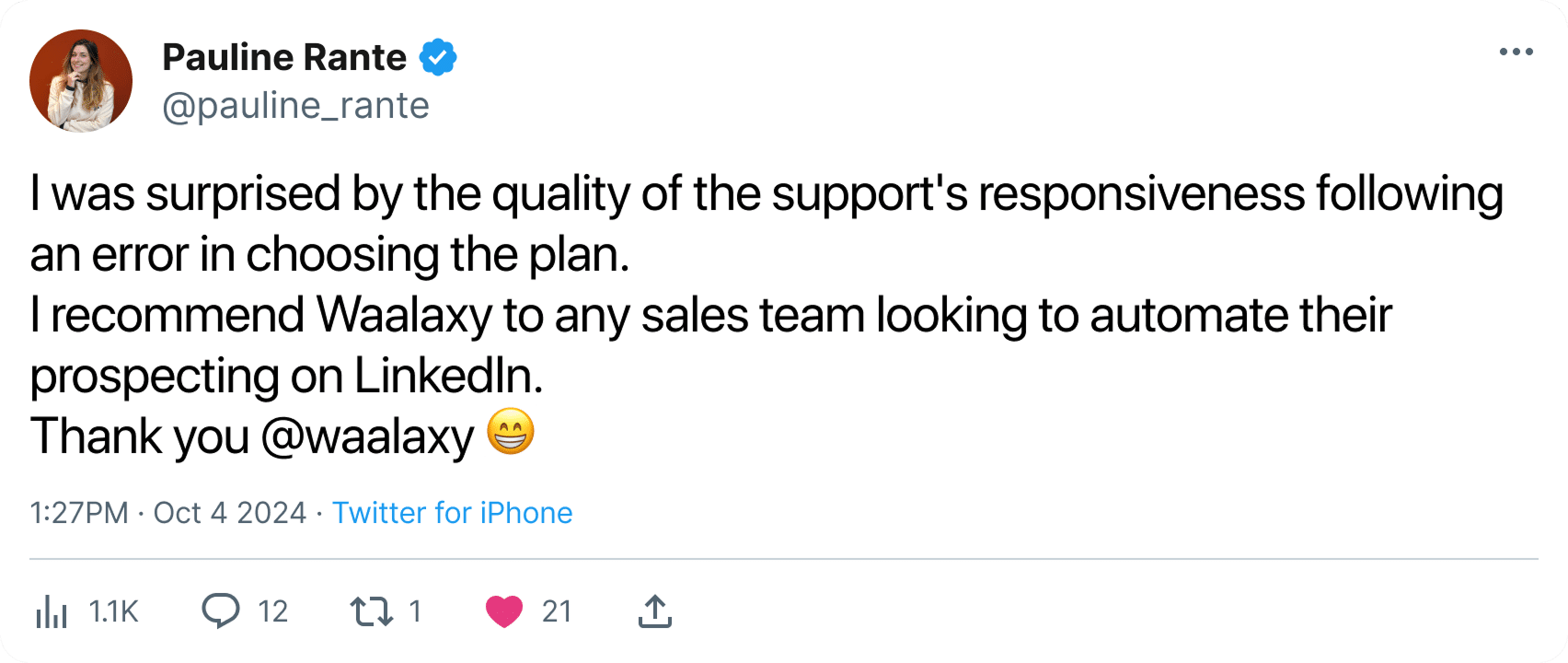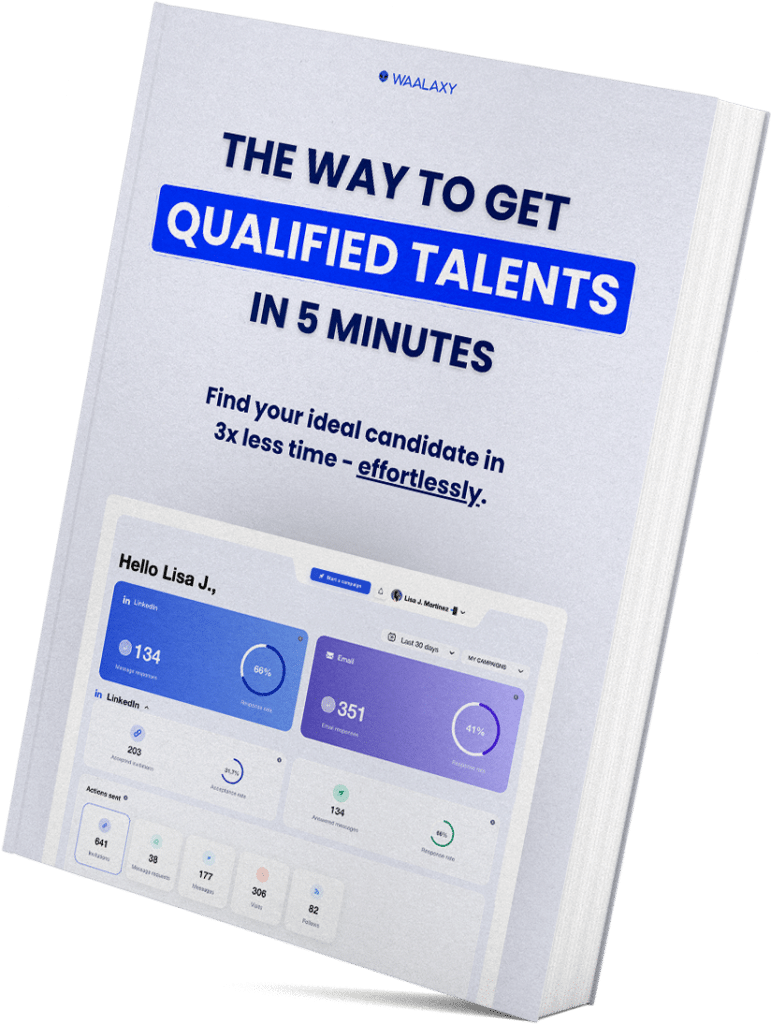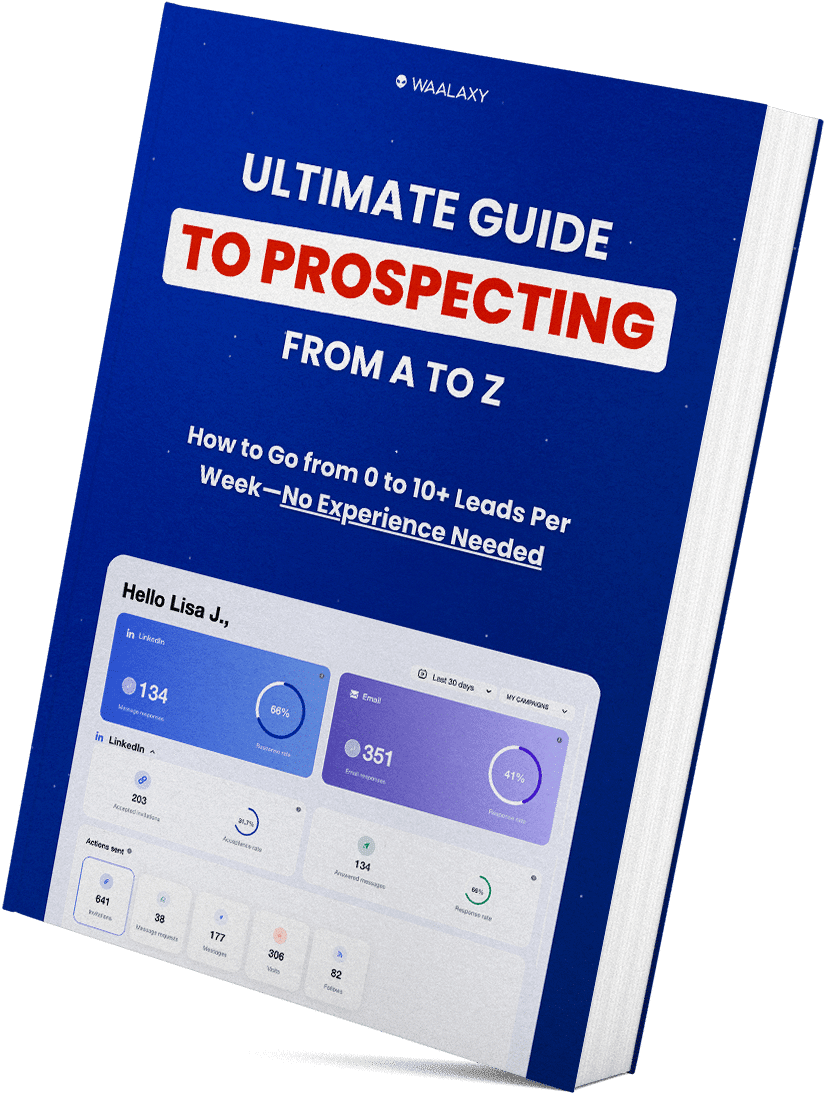Having trouble introducing yourself to people? Don’t panic! Today I’m going to show you how to make a quality introduction in different situations. Follow me 👇🏼.
On the program 💡 of our article, we’ll look at:
- ➡️ The essentials for writing an introduction.
- ➡️ How to avoid the pitfalls of writing an introduction.
- ➡️ 4 introductory examples (and I’ll tell you why it’s the bomb).
How to avoid pitfalls when writing an introduction?
Writing a good introduction effective can sometimes be a challenge, but by avoiding some common pitfalls, you can ensure that your introduction attracts attention and sets the scene for the rest of your content.
- Avoid generalities: don’t start with overly vague or generic statements that don’t offer specific information on the subject. Readers 🥰 want to know what they can expect from your text right from the start.
- Avoid information overload: The introduction shouldn’t reveal everything at once. Too much information can overwhelm readers and make the introduction tedious to read.
- Avoid clichés: Using trite phrases and clichés in your introduction can make your text predictable and unappealing.
How to write a good introduction? 4 examples
How to write an introduction for a research paper ?
Here is an example of an introduction for a research paper :
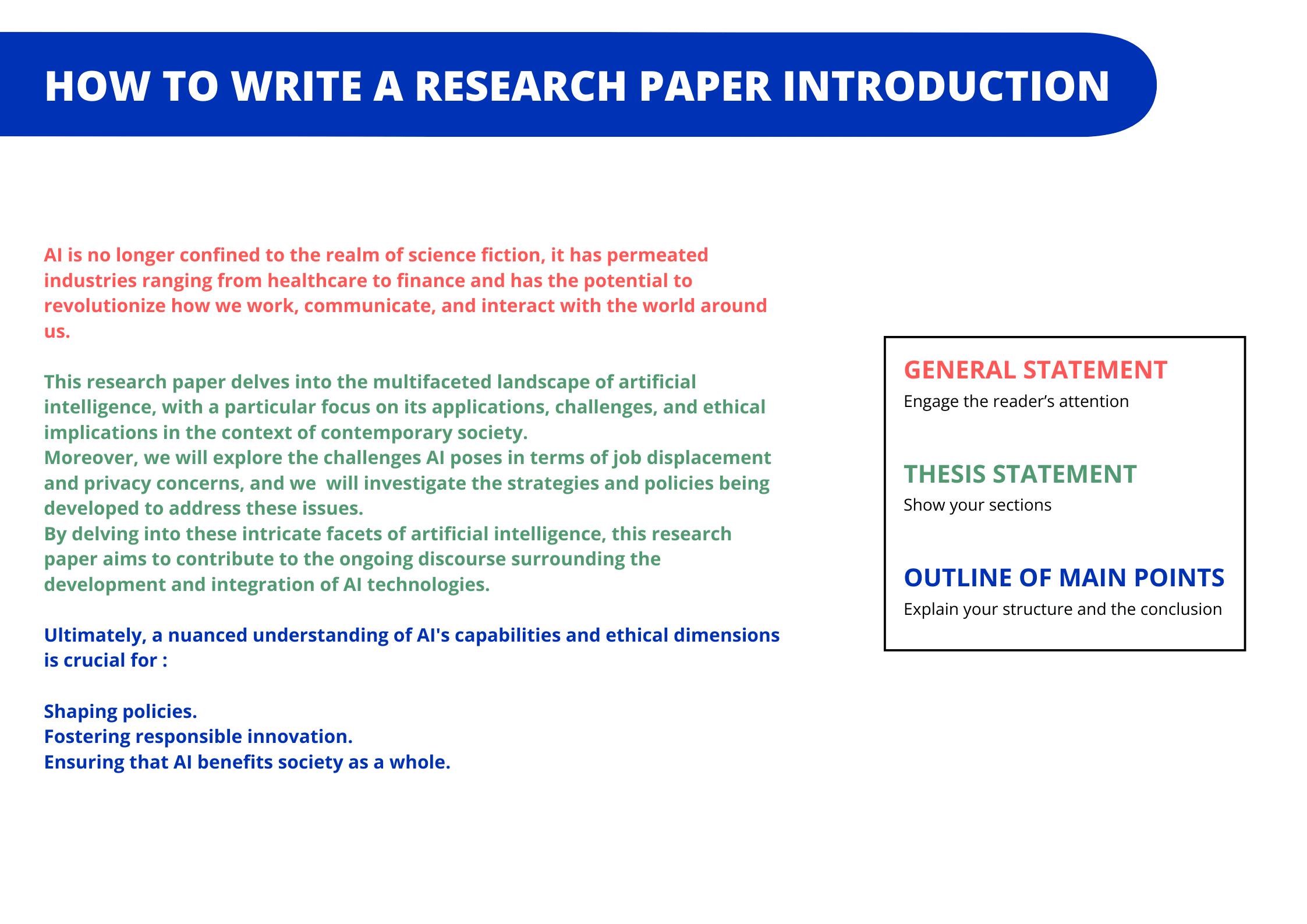
Why is it a success?
This introduction is considered successful for several reasons :
- 🟣 Engaging Start: It begins with a thought-provoking statement about the increasing prominence of artificial intelligence, which immediately captures the reader’s attention and relevance.
- 🟣 Contextualization: It provides a context for the research topic by highlighting the significance of artificial intelligence in contemporary society and its widespread impact across various industries.
- 🟣 Clear Objectives: The introduction clearly outlines the objectives of the research paper, stating that it will explore AI applications, challenges, and ethical implications, as well as examine societal impacts, challenges, and policy responses.
Writing an introduction article
To write a blog article whose subject is AI 🤖, here’s an introduction.
Why is it a success?
This introduction is designed to intrigue and educate the reader on the complex subject of IA.
- 🔵 We capture 🥅 attention: this introduction begins with a statement that sets the current context for AI as a common feature of our lives. Inevitably, it grabs our attention.
- 🔵 Questioning and curiosity: By asking rhetorical questions about the nature of AI, the introduction stimulates the reader’s curiosity and encourages further reading for answers.
- 🔵 Content announcement: it’s made clear that the article will cover the basics of AI, from its definitions to its practical applications, giving the reader a clear idea of what to expect.
- 🔵 Personal 🖇️ connection: the introduction speaks directly to the reader, assuming that he or she has wondered about the subject, thus establishing a personal connection.
- 🔵 Promise of informative content: the article is promised to provide educational and fascinating information, enticing the reader to read on to learn more about AI.
Introduction to a sale (selling a product)
I’m going to show you an introduction to a sales page for a Saas software.
Why is it a success?
The introduction strives to capture the reader’s attention by highlighting the advantages of the SaaS software in an intriguing way.
- Initial engagement: “Forward to simplified management” creates a relaxed, friendly tone, immediately establishing a connection with the potential reader.
- Problem and solution: Mention of a specific problem solved by your software clearly identifies the challenge the reader may face.
- Key benefits : Benefits are listed concisely and specifically.
A successful first contact introduction
Are you about to send your first message on LinkedIn, but don’t know how to go about it? Don’t panic, here’s an example.
Why is it a success?
First of all, this introduction is successful because :
- We recognize the recipient: By calling him by his first name 💓.
- Common ground: You establish common ground by identifying shared areas of interest and similar experiences.
- Valuing exchange: You show a desire for dialogue and exchange, which is often welcomed on LinkedIn.
How do you write a commentary introduction?
Here’s an example of a commentary introduction related to marketing:
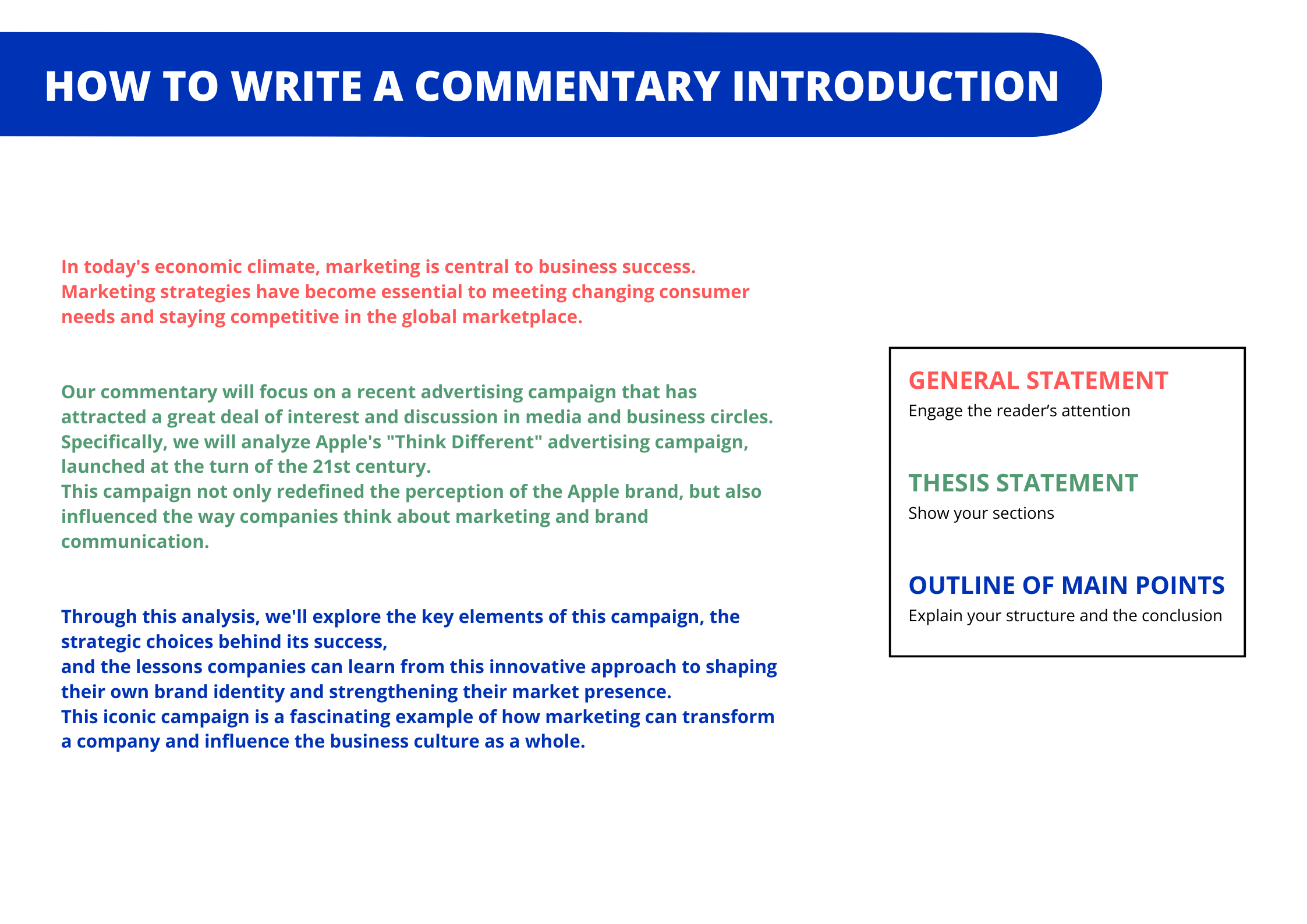
Why is it a success?
This commentary is successful for several reasons:
- 🔵 Clarity of introduction: clearly states that it will focus on Apple’s “Think different” advertising campaign.
- 🔵 Appropriate contextualization: highlights the importance of marketing in today’s economy.
- 🔵 Identification of subject and objectives: indicates which elements will be analyzed, such as key campaign elements, strategic choices and lessons to be learned.
How to write an introduction to philosophy?
Let’s find out how to make a good philosophy introduction:
Why is it a success?
Let’s find out why in a few quick points:
- 🟣 Identifying philosophical issues: clearly identifies issues related to marketing strategies and business, including ethical dilemmas, individual freedom and the quest for meaning.
- 🟣 Putting it into perspective: highlights the need to examine the morality of commercial actions and the quest for meaning.
How to write an introduction to an internship report?
Firstly, here’s an introduction for an internship report on an events company:
Why is it a success?
- 🔵 Company identification: identifies the events company where the internship took place, allowing the reader to set the context.
- 🔵 Report structure: announces the overall structure of the report, indicating that it will present information on the company brand, the intern’s assignments, skills acquired, challenges met, lessons learned, and impact on personal and professional development.
- 🔵 Positive tone: expresses a sense of enthusiasm and gratitude for the internship experience, piquing the reader’s interest right from the start.
How to write an introduction about yourself ?
Why is it a success ?
- 🔵 Engaging and Friendly Tone: It begins with a warm and friendly greeting, making it inviting and approachable.
- 🔵 Relevant Information: It provides relevant information about the person, including their age, nationality, interests, educational background, and achievements, which gives the reader a well-rounded view of the individual.
- 🔵 Personal Insights: The introduction offers personal insights into the person’s passions, values, and aspirations, helping the reader connect on a more personal level.
How to write an introduction for an essay ?
Why is it a success ?
- 🟣 Engaging and Informative: It starts with an engaging and informative statement about the evolving role of marketing in the modern world, immediately capturing the reader’s attention and highlighting the significance of the topic.
- 🟣 Clear Objectives: The introduction clearly outlines the objectives of the essay, stating that it will explore the fundamental principles of marketing, analyze strategies, and examine ethical considerations. This provides a roadmap for the reader.
- 🟣 Historical Context: It briefly touches on the historical roots of marketing, providing a broader perspective on the subject.
How to write a good introduction in 12 essential steps ?
Before immersing ourselves 🤿 completely in the various use cases, I’ll give you the steps you need to have an introduction slamming.
Writing an effective introduction requires a thoughtful, strategic approach. It will therefore follow a few key steps to write a powerful introduction.
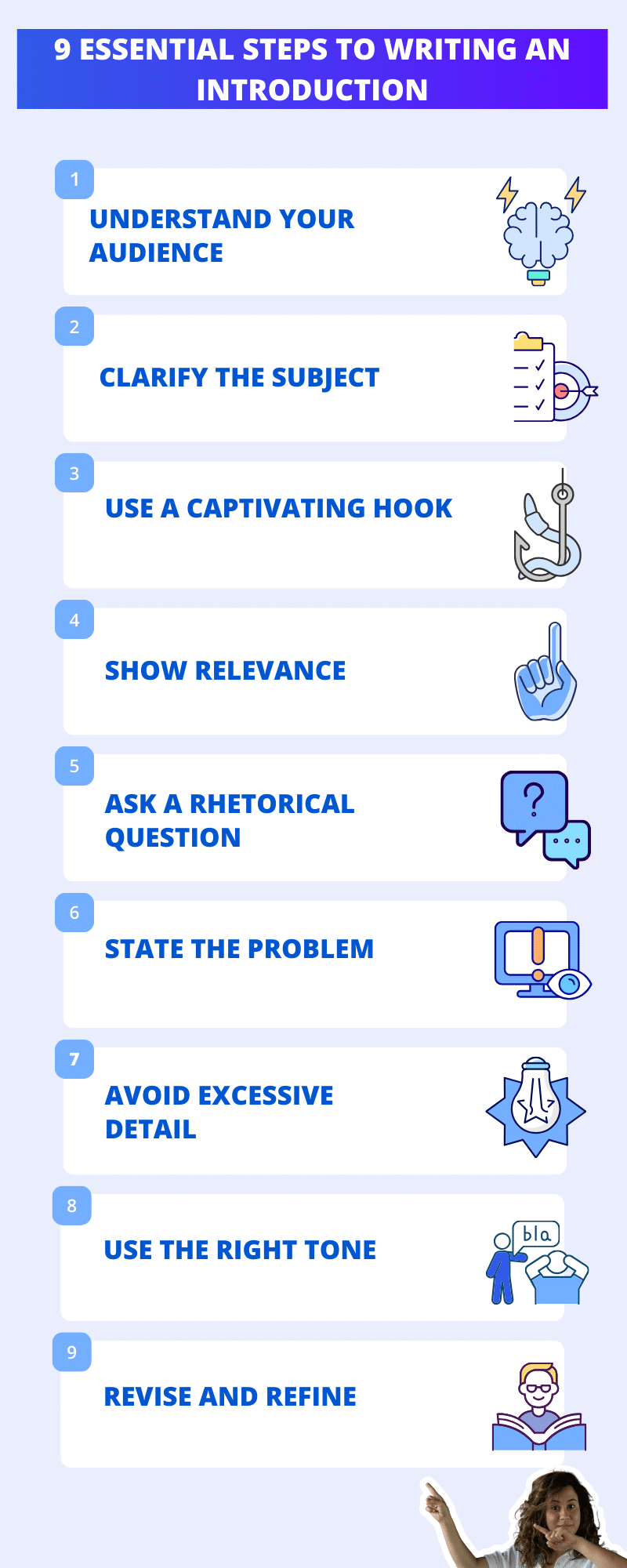
1) How to make your introduction engaging : Understanding your audience
First, put down your pen ✒️ (or your keyboard), because before writing anything, it’s essential to know your target audience. Do you know how to do this? I’ll tell you: thanks to persona. You must try to understand :
- What are your target audience’s expectations 🎯.
- What’s in it for the audience?
- What are their needs?
I don’t need to tell you again how crucial your persona is when it comes to setting up content. Personally, I don’t skip it.
A successful introduction must immediately pique their interest and address their concerns.
2) Clarify the subject
The introduction should clearly announce the main topic or theme. Avoid generalities and be specific so that your readers know what the content is about. You need to formulate in the simplest way 🧠.
3) Use a captivating hook
Start with a hook that grabs the reader’s attention and intrigues 👀. This could be a question, an interesting anecdote, a surprising fact or a quote, for example.
The catchphrase is the very first thing your audience will read. So it’s best to get it right. If your catchphrase is good, you’ve already done a great job of getting (some of) your readers engaged.
Want a sample tagline? Take a look at this one:
Content is the new oil. It’s the digital economy’s most valuable asset. Companies that master the creation and sharing of content will be the ones to succeed in the years to come.
4) Demonstrate relevance
Then, demonstrate from the outset why the topic is important ❗ to your readers. Explain how the content will be useful to them, help them solve a problem or answer their questions.
5) Establish the Purpose
Clearly state the purpose of your writing. If you’re writing an essay, present your thesis statement – a concise summary of your main argument or perspective. If it’s an article or report, outline the key questions you will address or the main themes you will explore.
6) Ask a rhetorical question
Here, this question rhetoric will encourage your readers to think about and engage with the content. Make sure the question is relevant to the topic.
7) How to write an introduction: State the problem
Introduce an issue, a challenge or a question you’re going to address in the article. This creates a sense of curiosity 🤔 in readers and encourages them to read on for answers.
8) Outline the Structure
Give the reader a roadmap of what to expect in your writing. Briefly outline the main points or arguments that you will discuss. This helps readers understand how your piece is organized and what they can gain from it.
9) Avoid excessive detail
Keep in mind that the introduction should be concise. Avoid revealing too much information or specific details. Reserve them for the development of your content.
10) The tone
Make sure the tone of your introduction is consistent with the rest of your content. If your tone is formal, keep it that way.
11) Review and fine-tune
Once you’ve written your introduction, reread it 📖 carefully. Make sure it’s concise, captivating and to the point. Correct spelling and grammatical errors if necessary. If you tend to make a few mistakes, don’t panic.
You can use a corrector and I encourage you to do so.
12) Write the introduction at the end
Writing the introduction at the end has several advantages, including:
- 🔵 Coherence: overview of the entire text.
- 🟣 Clear summary: summarize key points concisely.
- 🔵 Avoiding repetition: avoidable by adjusting the introduction accordingly.
- 🟣 Time-saving: you don’t have to constantly rework it to match the content you’re creating.
Article conclusion
Therefore, you guessed it, make an introduction may seem difficult to write at first, but rest assured, with practice it will get easier. That’s why we’ve seen :
- The essentials for writing an intro.
- How to avoid the pitfalls of writing an introduction.
- X introduction examples (and I’ll tell you why it’s the bomb).
Article FAQ
We’ll be saying goodbye soon 😔, but I still have a few notions to share with you!
Can you use AI to write an intro?
Don’t be shy about using the IA. You can use this tool to write an introduction, for example to :
- Generate ideas.
- Formulations.
- As well as content suggestions.
However, it’s important to note that using AI in this context requires a considered approach to ensure that the message is authentic, relevant and personalized.
How do I announce a topic?
Announcing the subject is an essential part of the intro to an essay. This is where you set out clearly and precisely what you’re going to write about. Here’s a list of the boxes you need to tick:
- Be clear and precise.
- Use simple language.
- Avoid generalities.
- Avoid rhetorical questions.
- Be relevant.
What are the catchphrases?
Here’s a table listing the most common catchwords for an introduction.
| Type of catchword | Example |
|---|---|
| Intriguing question | “What drives human beings to explore the unknown?” |
| Anecdote | “The incredible story of a woman who survived against all odds…” |
| Surprising statistics | “Over 70% of people fail to achieve their New Year’s resolutions.” |
| Famous quote | “As Martin Luther King Jr. said, ‘I have a dream’…” |
| Shock statement | “Global warming is threatening our planet at an alarming rate.” |
| Evocative scene | “Imagine yourself on top of the mountain, the wind whipping your face…” |
| Contradictory statement | “Despite all the advances in technology, we’re becoming increasingly disconnected from each other.” |
| Mysterious revelation | “In the heart of the old library, a forgotten manuscript tells an incredible story…” |
| Rhetorical question | “What does success really mean in an ever-changing world?” |
| Surprising announcement | “Discover today the age-old secret that can change your life.” |
What are the 5 parts of a good introduction?
So, here are the 4 key steps to an effective introduction:
- 1️⃣ Capturing attention.
- 2️⃣ Contextualizing the subject.
- 3️⃣ Defining the issue.
- 4️⃣ Plan announcement.
- 5️⃣ Ask a rhetorical question.
How do you spice up an introduction ?
- Use a strong hook.
- Tell a story.
- Invoke the senses.
- Begin with a bold statement.
- Use humor.
- Ask rhetorical.
- Incorporate a quote.
- Establish a connection with your audience.
What is the 3 paragraph rule in the introduction ?
This rule helps in organizing the introduction effectively. Here’s a breakdown of what each paragraph typically contains: 👇🏼
- First Paragraph : the first paragraph is where you introduce the general topic of your essay. This is where you catch the reader’s interest, often with a hook such as a compelling question, a surprising fact, a quote, or an engaging anecdote.
- Second Paragraph : in the second paragraph, you delve into the background information or context surrounding your topic. This might include historical, cultural, or social details, definitions of key terms, or a brief explanation of important concepts or theories. This paragraph is crucial for setting the scene and providing the necessary information the reader needs to understand the topic in depth.
- Third Paragraph : the final paragraph of the introduction is typically where you state your thesis or main argument. The thesis statement should be clear, concise, and specific, outlining your position or the main point you will argue in your essay. Additionally, this paragraph often includes a brief roadmap, outlining the major points or the structure of your essay, to guide the reader on what to expect in the main body.
Now you know how to write an introduction 🚀.



